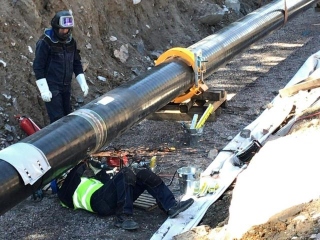Europe's newest gas link set to hit Gazprom prices around the Baltic Sea

OSLO (Reuters) - Europe's first new gas interconnector in a decade, linking Finland and Estonia from January, will weaken Gazprom's hold on the Baltic Sea region and spark price competition, the pipeline's owners said.
The pipeline, called Balticconnector, will help Finland diversify its gas supplies which are solely Russian, and can also send gas to the Baltics, whose gas comes from Russia and Lithuania's Klaipeda liquefied natural gas (LNG) terminal.
Although the pipeline will partly carry Russian gas, it is a mostly European Union (EU)-funded project, with the EU covering 75% of its €300 MM ($330.81 MM) cost. Its owners, Finland's Baltic Connector and Estonia's Elering cover the rest.
In the absence of other piped supplies from Europe at the time of its opening, Balticconnector will only carry gas from Russian entry points in Finland and the Baltics, regasified LNG from Klaipeda, or stored gas from Latvia's Incukalns.
Prices between them vary as Russia has different supply contracts in Finland and the Baltics, the stored gas value is seasonal and weather-related, while LNG follows the global market. Abundant and cheap LNG has already reduced Gazprom's share of the wider European market.
Gazprom may have to change its pricing in Finland to compete against LNG, the pipe's owners told Reuters.
"Αs Gazprom supply contracts are different for the different countries then there is also competition between these contracts... There is more import capacity of Russian gas in the region than LNG," Elering's market development manager Erkki Sapp said.
Baltic Connector's Chief Executive Herkko Plit also expected Gazprom to lower its prices.
"Remember what happened in Klaipeda when the terminal opened there? Gazprom dropped their prices by 20%. Gazprom might, as an active player in the (Finnish-Baltic) market, adjust their prices accordingly," he told Reuters.
"REDUNDANT INFRASTRUCTURE"
Gazprom's prices may also come under further pressure from 2022. A connecting pipeline between Lithuania and Poland, GIPL, is scheduled to be completed by the end of 2021, providing physical access to the gas infrastructure in central Europe.
Gazprom did not reply to a request for comment. Its data show the firm exported 2.6 billion cubic metres (Bm3) of gas to Finland in 2018, 1.3 Bm3 to Latvia, 1.4 Bm3 to Lithuania and 0.4 Bm3 to Estonia.
Russia's National Energy Security Fund, a think tank whose views are usually in line with Gazprom's, told Reuters that it didn't expect Balticconnector to be of much use.
"The pipeline may not be filled with gas at all. In order to fill it, it is necessary for Finland to buy more gas from Gazprom and for Estonia to offer a higher price. I don't think it makes sense now," its deputy director for gas Alexey Grivach told Reuters.
"Balticconnector is a typical example of a redundant infrastructure that was built only to absorb money from the EU and create a mythical connection of markets that can be used only once in 10 years," he added.
Elering's Sapp did not share the concern, adding that some market participants had even worried whether the pipe's capacity was sufficient.
($1 = €0.9069) (Additional reporting by Gederts Gelzis in Riga, Maria Grabar in Moscow and Ekaterina Kravtsova in London, editing by Terje Solsvik and Emelia Sithole-Matarise)

- ADNOC Gas awards $2.1 B in contracts to enhance LNG supply infrastructure
- U.S. Department of the Treasury releases final rules for clean hydrogen production tax credit
- Tecnimont to build waste-to-biogas plant to fuel local kitchens in India
- Indonesia regulator confirms disruption at bp's Tangguh LNG project
- Topsoe, Aramco sign JDA to advance low-carbon hydrogen solutions using eREACT™



Comments